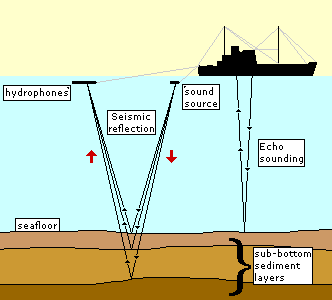- be able to distinguish between transverse and longitudinal waves and appreciate the circumstances in which either or both might occur
Transverse waves Vibrations at right angles to the direction the waves travels.
i.e. When a disturbance is created, the molecules 'vibrate', basically up and down, which is perpendicular to the motion of the wave.
Graphical representation

[Right-click view image]
Longitudinal waves Vibrations in the same direction as the waves travels.
i.e. When a disturbance is created, the molecules 'vibrate' to and fro, forwards and backwards which in in the direction of the wave motion.

During earthquakes, both occur simultaneously :
http://en.wikipedia.org/wiki/Earthquake_wavesThough you don't have to know the details.
-appreciate the way a wave can be reflected off a plane barrierLight waves, sound waves, examples of transverse and longitudinal respectively reflect when hit a surface.
Regular and irregular refelction of light


Uses of reflection of sound (echo)

 -appreciate the way in which a wave can change direction as its speed changes
-appreciate the way in which a wave can change direction as its speed changesI think this is the explanation : relating it to the previous explanation, the phenomena can be called as refraction.
When a light wave passes form an optically denser median to a rarer medium or vise versa the speed as well as direction changes.

In the picture : A ray of light enters from air into glass
- appreciate how reflection and refraction properties can be applied to understand the transmission of light down an optical fibre
Light can be trapped by total internal reflection inside a glass rod and 'piped' along a curve pat. A single, very thin glass fibre behaves in the same way.
See, you must know what is critical angle of a substance for the explanation. Critical angle is when the angle of refraction is 90*.
http://www.medrounds.org/optics-review/uploaded_images/Figure18-774908.jpgIn the picture : R2 shows the critical angle.
If this critical angle is exceeded, total internal reflection occurs. R3 in the picture shows total internal reflection.
Optic fibres use this principle to propagate light rays or any other electromagnetic radiation to long distances.